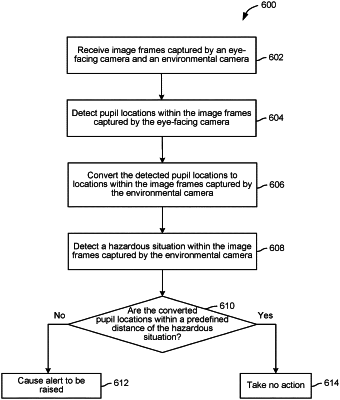| CPC G06V 20/20 (2022.01) [G02B 27/017 (2013.01); G02C 11/10 (2013.01); G06F 3/013 (2013.01); G06V 40/18 (2022.01); G06V 40/193 (2022.01); G02B 2027/0178 (2013.01)] | 16 Claims |

|
1. A computer-implemented method for generating safety hazard alerts, the method comprising:
receiving a first image frame captured by a first camera and at least one second image frame captured by a second camera, wherein the first camera and the second camera are secured to a pair of safety glasses, the first camera points away from a user wearing the safety glasses and towards an environment, and the second camera points toward the user;
determining, based on the first image frame, a location of a hazard in the environment;
determining, based on the at least one second image frame, at least one eye location;
determining that the user has not noticed the hazard based on the location of the hazard and by mapping the at least one eye location to at least one gaze location in the first image frame via a mapping matrix storing a plurality of mappings from locations in image frames captured by the second camera to locations in image frames captured by the first camera, wherein the mapping matrix is computed using a set of target objects placed at predetermined locations within the environment;
responsive to determining the user has not noticed the hazard, causing an alert to be generated; and
performing a re-calibration based on another plurality of mappings from locations in other image frames captured by the second camera to locations in other image frames captured by the first camera.
|